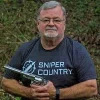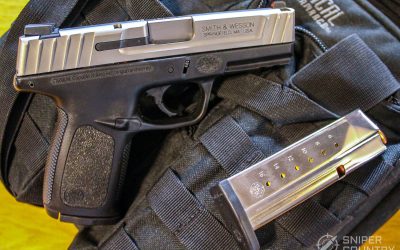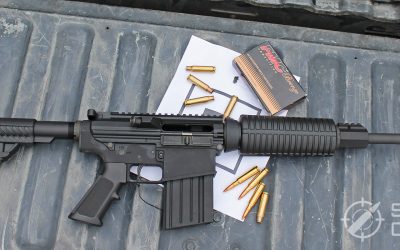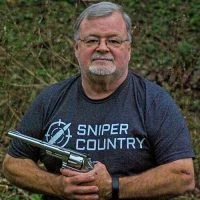I owned a 9mm Shield once upon a time and foolishly sold it. That gun was reliable and easily carried inside the waistband. It was well-built, felt good in the hand and went “bang” every time it was supposed to. I don’t remember what gun I just had to have in its place, but it was not my best moment. I should have kept it. I will write this article from the standpoint of my experiences with my Shield, now gone. So, I needed another one to photograph. Thankfully, my friend Mark came through for me – he has one that he let me take photos of. Due to the time I spent shooting and carrying my Shield (make sure to look into CCW insurance), hopefully I can convey what a great gun it is. (In case you’re wondering, Mark carries this gun daily in a Crossbreed IWB holster and it shows some wear. I cleaned it, but probably not as well as I could have…if you’re an OCD-pistol-cleaner, please forgive me – we were in a bit of a hurry).
I remember when the Shield came out in 2012. S&W team member Julie Golob was shooting one at long ranges in a video I watched on You Tube. She is a very personable, likeable young lady who actually answers her emails from shooters like me – I had a couple of questions for her. Anyway, she was hitting the targets like it was easy, at 100 yards or so…that says a lot for the shooter, but even more for the gun. If the Shield is that accurate way out there, think how great it would shoot up close. It is an easy, accurate gun to shoot.
As for what I’ll cover in this review, I’ll start off by talking about the variety of Shields out there, then we’ll hit the specifications. Next will come the history of the “M&P” brand, with the pistol’s components photographed and discussed. We’ll end with my impressions of the Shield and my experiences shooting it. We’ll end after that.
One Popular Gun
The Shield is one of the best-selling concealed carry pistols out there. Smith and Wesson (S&W) sells them about as fast as they can make them, in 9mm, .40 S&W and .45 ACP. The 9mm is the most popular (see numbers below).
If you look at S&W’s website and go to the Shield page, you will see no fewer than forty-four different Shields in the three calibers listed above. Why so many? Because people are buying them. Do you want a plain-Jane Shield in 9mm but with a thumb safety and you live in California? No problem. How about one in .40 with a green laser? No problem. Oh, you wanted a .45 with tritium night sights? Order one, it’s on the web page. I counted the following numbers in each caliber:
- 9mm – 19 total
- .40 – 15 total
- .45 – 10 total
Now, when I say total, I am including all variations within that caliber. These variations among the calibers include:
- Thumb safety, no
- Thumb safety, yes
- Integrated Crimson Trace red laser
- Integrated Crimson Trace green laser
- Integrated Laserguard Pro green laser/light combo
- Hi-Viz (fiber optic) Sights
- Tritium Night Sights
- Massachusetts-compliant
- California-compliant
- Most any combination of the above
If you want to peruse the S&W page that lists these, go here and drop down the “Series” menu choice to “M&P SHIELD” – that way, you can see all the variations, or sort them by caliber.
Without totally boring you, you begin to see a trend here. Evidently, S&W likes the Shield and so do thousands of gun buyers. There’s even one with a frame in flat dark earth, if that melts your butter. So, no matter what you want in a carry gun that has the S&W logo on it and starts with “Shield” in its name, you’ve got it.
Before we get too far into this, let’s look at the “base” Shield’s specifications. Please remember that you can get this in many variations. These specs apply to this model (no thumb safety, base sights):
| Length: | 6.1 in. |
| Height: | 4.6 in. |
| Width: | 0.95 in. |
| Weight: | 18.3 oz. |
| Capacity: | 7-round magazine (shown above), 8-round magazine with spacer |
| Barrel: | 3.1 in., stainless, Armornite© finish |
| Slide: | stainless, Armornite© finish |
| Frame: | Polymer |
| Sights: | steel, white dots |
| Loaded Chamber Indicator: | view port, rear of barrel hood |
Again, look at the listing of options above and check the website for specifics. You should be able to find one that will satisfy you in any of the three offered calibers.
OK…now we’ve seen the list of options, calibers and the specs. It says “M&P” on the slide – what does that mean?
BONUS OFFER: Get your free shooting range targets to print at home!
Get your free targets to print at home!
S&W And The History Of The M&P Guns
In 1852, gunsmiths Horace Smith and Daniel Wesson formed the partnership Smith & Wesson, with a company resulting from that union. They had many financial troubles, so in 1854 they sold the company to a clothing maker – Oliver Winchester. (Heard that name before, eh?) In 1866, Winchester renamed the company the Winchester Repeating Arms Company. That same year, Smith and Wesson formed their second company called Smith & Wesson, which is still in operation. Enter the M&P guns…
The M&P series of handguns goes back to 1899. The S&W company designed and built a series of revolvers designated “M&P” (Military and Police) …here’s a WWII Victory model:
The revolvers were chambered in a new caliber – the .38 Special. That’s where the old warhorse caliber came from – the M&P revolvers. The guns were designed to be of use to both the military and to law enforcement, hence their M&P branding. The “.38 Military & Police” revolver became the Model 10, which is still in production, with over 6 million guns produced. The gun pictured above was one of over 800,000 guns produced for the British Commonwealth. It was a descendant of the original .38 Military and Police revolver.
Cut to modern times…S&W rejuvenated the M&P moniker with its resurrection in 2005 and is currently producing rifles and handguns so marked. Rifles are of the AR-type and chambered accordingly, while handguns are now semiautos and are chambered in several calibers. (There is one revolver that bears the M&P logo – a snub-nose .38). The Shield was introduced in 2012, with over 1 million produced in three years. In 2017, the 2.0 version of the M&P handguns was introduced, with features and upgrades that are in use to this day. For an interesting read, check out S&W’s History web page – it shows when specific guns were introduced and talks about the company in some detail.
So, now we know where the M&P series came from and the Shield itself…what makes it so special? Let’s look at one taken down for cleaning and talk about the parts…












There you have it…the gun torn down for cleaning into its major components. This shows the attention to detail that S&W employs in its manufacturing process. There were no finishing or machining flaws visible. One feature I really like is that the Shield uses a captive recoil spring…you have no idea how many times my sausage fingers have made a non-captured recoil spring shoot out of a gun like a scalded cat. I’m not the most mechanical guy around. (The worst one to get back inside the gun in my experience is the Taurus Spectrum .380 – I have to wrestle that one into the slide). Anyway, no problem here – just pop it out and back in.
Popular Articles
Shooting The Shield… And Other Thoughts
I am a reloader. I freely admit that. I am proud of that. I make no excuses for being such a creature. Having said that, you might think that the next thing I’m going to say is how well my reloads shot in my Shield. OK…they did very well. Not bragging or anything, they just worked well. But, it wasn’t only my rather tame handloads…my Shield would eat whatever I fed it, handloads or factory stuff. The polished feed ramp (see the photo above) was slick enough to load whatever bullet type I would try. My reloads use my cast Lee 124-grain round-nose bullet, but the Shield fed them no problem and then would turn around and allow magazines of defensive jacketed hollow point loads to be shot with no glitches.
Slick Grip
As you can see from this photo, the grip texturing leaves something to be desired. You want an 18-ounce subcompact 9mm to stay put in your hand when you shoot it – this texturing could be more aggressive.

I think the best-textured grip from any mainstream gun factory right now would have to be that of the Taurus G2C. THAT grip is sticky, and plants the gun firmly into your hand. They have the right idea here, they just need to go the next step and make it rough so it will stay put when you shoot it.
Sights
My Shield had the plain, ordinary three-white-dot arrangement – they worked. The rear sight is drift-adjustable for windage…this is where a sight pusher comes in handy. Seems like I have to move all my pistol rear sights to the right for some reason-I guess I just see things differently. I had to move the Shield’s sight, but I did it the old-fashioned way – with a hard rubber mallet. This is NOT the recommended way to move a sight, but it sure beats using a metal rod of some sort and whacking the slide-locked-in-a-vise sight with the rod and hammer. Again, even if you have to take whatever gun you’re adjusting to a gunsmith, please do so. You don’t want to mar the finish on any gun. Another thought-sight pushers are not that expensive. You can get some at Amazon – they start at about $35. I think a sight pusher and a trigger pull gauge of some kind would be good additions to any serious handgun shooters’ equipment collection.
The gun that you are looking at in this article wears night sights. That’s one of the many options mentioned above that you can get for your Shield. Night sights do add a lot to a pistol – even if you are in total darkness, your sights are visible. Of course, if you can’t see your target, maybe you shouldn’t be shooting, but that’s a different article. The Shield does have a rail of sorts – you could mount a laser sight or a light. I was looking at one today in friend Duane’s gun shop that has a red laser built into it. I would think that, if you know you are going to mount a laser sight on your Shield, you might just go ahead and buy one that way from the factory. You can get red or green and a light is optional as well with some lasers. The gun is more streamlined with the factory-installed sight.
The Grip and Recoil
I do not have any targets put away from when I had my Shield, but I do remember how well it shot. It was an accurate gun and was fairly easy in the recoil department. With the high hand hold that you can get on the frame, it really helps mitigate muzzle rise after the shot. Another plus is the 8-round magazine…you can get all three fingers on the grip with it installed. The 7-rounder leaves a bit to be desired in the pinky-finger-on-the-grip area (as with about 90% of other subcompact 9mm pistols out there), but still affords a decent grip. With the longer magazine, though, you have greater control over the gun and can help hold it down in recoil.
Running The Gun
To use the current popular phrase that just means shooting the gun, I wanted to talk just a bit about the controls that the Shield provides. When you “run” this gun (shoot it), you have the controls you need available within easy reach. Here is the pic from above:

Notice the slide stop. It actually works. It is not only a slide stop, but a slide release as well. Usually, slide stop levers on these small guns are there mostly so you know that the slide will lock back after the last round’s been fired and are not meant to be functional slide release levers. This lever works, although I do wish they made the horizontal serrations a bit deeper for a better purchase. It does take some effort to release the slide, but it will do so with the right pressure on it. The magazine release is very usable. It is small enough to be out of the way but not so large that is sticks out and allows accidental dropping of the magazine. As a lefty, one of the things I look for in pistols that concerns the magazine release is reversibility. Can you move it to the other side of the frame? With the Shield, in a word, no. It is not reversible. At least we lefties are getting good at pressing the release with our trigger or second finger of our left hand…we’ve had to adapt. The same goes with the slide stop/release.
BONUS OFFER: Get your free shooting range targets to print at home!
Get your free targets to print at home!
Trigger & Takedown
Another thing – look at the trigger. It does not use the Glock-style safety blade in the middle, but is hinged. When you press on the bottom part of the trigger, you release it to do its thing and fire the gun. If for some reason, you only got the top part of the trigger, it wouldn’t fire. I doubt that that would be an issue, but I guess it could. Anyway, I’ve heard no complaints about S&W’s trigger (other than pull weight and reset, but that’s different). The last thing to pay attention to is the takedown lever. Swing it down as pictured, pull the trigger and the slide comes off. S&W, in their Shield owner’s manual, tells you to take a screwdriver and push down on the “yellow(ish) sear deactivation lever” in order to get the slide off, but a trigger pull accomplishes the same thing. Friend Mark didn’t know that – he was glad to hear it. He was hunting around for something to push that lever down when I pulled the trigger and removed the slide. It’s a small thing, but it made him happy. We never seem to have the right tool around when we need it. That’s one of the only things I don’t like about the Shield if you do their screwdriver method, or some other guns as well – that you have to use something other than your hands to take the gun apart. (Don’t get me started about takedown pins that come all the way out and are tiny. I’ve temporarily lost a few of them). The only exception that I’ll make to the no-tools-takedown is my Taurus Spectrum. You do need a screwdriver or case rim to turn the takedown slotted lever 90 degrees, but then the slide comes right off without a trigger pull. Works very well.
As for the rest of the takedown, it’s just like other semi-autos…remove the captured recoil spring and rod and pull the barrel out. Clean everything (especially under the barrel hood and in the corners of the top of the barrel…a toothbrush works well). Also, before you’ve put a few hundred rounds through the gun, pay attention to the slide rails. Run a rag on something rigid that won’t hurt the finish down into the grooves and clean them well. A drop or so of gun oil or lube in the rail slots will help ensure your gun will run.
To Sum Up…
There’s a reason that the Shield is probably the best-selling concealed carry gun as of this date. The gun is fairly inexpensive, is made by a reputable gun manufacturer, and comes in more flavors than Baskin Robbins has (31). If you can’t find one of the 44 variations to suit your taste, you’re not trying. If ever I bought another one, it would have the built-in green laser (more visible in daylight) and light. Everybody’s different, but you should be able to find one that will give you years of service.
When you consider just how many third-party items are made for the Shield (holsters, lasers, triggers, etc.), you see just how popular the gun really is. There is a reason that S&W sells so many of these little gems…they work. Reliable, accurate and tough – I think you could sure do a lot worse when you select a carry gun. If you’ve had experience with a Shield of one sort or other, comment below, and as always thanks for stopping by!












![9mm Glock Models [Ultimate Guide]](https://snipercountry.com/wp-content/uploads/2018/10/Glock-17-vs-Glock-19-vs-Glock-26-vs-Glock-41-vs-Glock-43-WM-400x250.jpg)
![Handgun Caliber Chart [2025 Ultimate Guide]](https://snipercountry.com/wp-content/uploads/2018/10/Handgun-Caliber-Comparison-400x250.jpg)
![Rifle Calibers [Ultimate Guide]](https://snipercountry.com/wp-content/uploads/2018/12/Header-1900-400x250.jpg)






20 Responses
Great discussion. I carried one for awhile, but was never crazy about the trigger. It was compact and light. Now, I think Sig’s 365 kicks everything else hands down. I had Sigs forever, and three 365s.
Snake (not going to ask how you got that nickname!), I agree about the 365 – it’s great, and very popular. The Shield comes into the picture for those who may not be able to afford the Sig or who are S&W fans. It is a viable alternative. Thanks for wiriting!
I’ve had my S&W ? for about 5 years , love it. It’s a keeper !
Larry, I regret selling mine. Hang on to it! Thanks for the comment.
I am sure the Shield is a good gun, BUT I am old enough that I remember S&W caving to Clinton. And I have never bought a S&W because of that. I do have a couple of revolvers that I had before that, but there are so many guns now that are equal to S&W Semi-autos that I don’t ever consider them. I now carry Beretta 92 and lately APX on my hip and SCCY on my ankle… The SCCY is a pretty good gun and Cheap $$. I have bought 3 for what I can buy a shield…
Tom, you have your reasons for not buying S&W. I do understand about the plethora of 9mm sub-compacts on the market. I owned a SCCY for awhile – decent gun. The Berettas are great guns. Thanks for writing!
Love my shield, it hasn’t left my side for yrs….although I have many others, it’s my EDC. Lost track of rds but I have yet to have 1 failure, says alot about this 9mm. Great article!
Adam, thanks for the kind words. I’m glad your Shield has not let you down – hopefully it never will. Thanks for writing!
I bought the Shield in .40 S&W earlier this year when Bass Pro Shop had them on sale for only $249 plus tax.
I’ve been happy with it so far, it shoots well, recoil is not excessive and it conceals well in my Galco IWB holster.
Tommy, sounds like you got a heck of a deal. $249? Wow! I’ve had a few reports of the Shield being not so well-mannered in .40 — snappy — but if you are shooting it and it works, great! Glad you found a good holster to carry it in. Thanks for writing!
Love my S&W Shield 9mm. Well made and easy to carry.
John, you’ve got the main idea. Well made and easy to carry (and I can add reliable)…what’s not to like? Thanks for the comments.
I have carried a Shield in .45 for about 2 years and fired it maybe four times. It is always very accurate even for someone who doesn’t visit the range too often and has given it a proper break in.
Julio, I was stoked when I heard that a .45 Shield was coming out a few years ago. That would be a nice gun and would compete with the Springfield XDS. Hopefully you can get to the range more often and practice more – it’s a great gun and fun to shoot.
I bought my 9mm Shield a couple years ago. It came with (for extra money) a green Crimson Trace laser. The Crimson Trace wasn’t built in but it’s housing is a custom molded fit for the M&P. The laser and the thumb safety are the two main reasons I bought the pistol. I still utilize the safety but I’ve taken the crimson trace off (for now) to make concealing it easier.
Jason, the CT laser, especially green, is a good addition to a Shield but only if you can carry it well. Sounds like you’ve made the right decision for your needs. At least you have the option of putting it back on in the future if you get a different holster or whatever. As for the thumb safety, my gunshop-owner buddy Duane tells me he sells way more pistols that offer optional safeties with those safeties than without – there are still a lot of folks who want that extra feature. Thanks for writing!
Do you know where I can get a new frame for my mp 9c
Cody, not offhand. I suggest you start with S&W – call them and see what they recommend. If you’re looking for an OEM frame, they’re the best place to start. Thanks for writing!
I bought the 2.0 9mm shield about six months ago. First striker fired pistol I have owned. I like it as it shoots well and with about 300 rounds through it has had zero failures. Very easy to break down and clean.
Clay, the Shield is one of S&W’s best sellers. It’s a great gun for concealed carry or just to shoot for fun – they sell a ton of them. Thanks for writing!